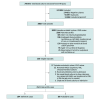Interpreting Blood Culture Results as Early Guidance for Infective Endocarditis
- PMID: 40310644
- PMCID: PMC12046426
- DOI: 10.1001/jamanetworkopen.2025.8079
Interpreting Blood Culture Results as Early Guidance for Infective Endocarditis
Abstract
Importance: Few bedside tools with defined accuracy have been described that are useful to alter bayesian prior probability for infective endocarditis (IE) in patients with bacteremia.
Objective: To evaluate the accuracy of simple blood culture parameters to guide pretest probability of IE.
Design, setting, and participants: This multicenter, retrospective case-control study of blood culture data in adults with IE vs without IE was conducted at 3 acute care public hospitals in the Los Angeles County Department of Health Services between December 2018 and August 2022. Patients were individuals aged 18 years or older who had positive blood cultures and met the inclusion criteria, including cases who met the Duke criteria for definite or possible IE, and control cases who did not have concern for endocarditis.
Exposures: Positive blood cultures for methicillin-susceptible Staphylococcus aureus, methicillin-resistant S aureus, Enterococcus faecalis, low-risk Streptococcus species, or high-risk Streptococcus species.
Main outcomes and measures: The primary outcome was the negative likelihood ratio (LR) of having endocarditis based on the number of positive blood cultures on admission. Positive LRs, evaluation of 2 or more of 4 bottles positive on admission, bacteremia lasting for at least 2 days, and combination groups were secondary outcomes.
Results: A total of 252 eligible patients with IE (182 male [72%]; median [IQR] age, 54 [38-65] years), including 164 definite and 88 possible IE cases, and 455 controls (321 male [71%]; median [IQR] age, 53 [41-63] years) were identified. The negative LR point estimates for having IE with only 1 of 4 positive blood culture bottles on admission ranged from 0.05 (95% CI, 0.01-0.37) for E faecalis to 0.12 (95% CI, 0.03-0.49) for methicillin-susceptible S aureus. Sensitivity analysis of cases restricted to definite IE found similar results. Blood culture clearance by day 2 also had modestly helpful negative LRs for methicillin-resistant S aureus (0.24; 95% CI, 0.13-0.42) and Enterococcus species (0.34; 95% CI, 0.21-0.56). If patients had 4 of 4 bottles positive on admission, positive LRs were helpful for Enterococcus species (LR, 4.21; 95% CI, 2.53-7.02) and high-risk streptococci (LR, 5.35; 95% CI, 3.39-8.42) and for all organisms with persistent bacteremia (with LRs ranging from 1.78 [95% CI, 1.36-2.34] to 9.60 [95% CI, 3.43-44.60]). If both were true, the positive LRs ranged from 1.63 (95% CI, 1.17-2.28) to 8.59 (95% CI, 3.43-21.55) for all organisms.
Conclusions and relevance: In this case-control study of patients with and without IE, the number of initial positive blood culture bottles and days to culture clearance were helpful to adjust pretest probability of IE. These findings may help guide diagnostic and therapeutic decisions around bacteremia early during hospitalization.
Conflict of interest statement
Figures


References
Publication types
MeSH terms
LinkOut - more resources
Full Text Sources
Medical
Miscellaneous

